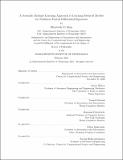| dc.contributor.advisor | Karen Willcox. | en_US |
| dc.contributor.author | Qian, Elizabeth Yi. | en_US |
| dc.contributor.other | Massachusetts Institute of Technology. Department of Aeronautics and Astronautics. | en_US |
| dc.date.accessioned | 2021-05-24T20:22:44Z | |
| dc.date.available | 2021-05-24T20:22:44Z | |
| dc.date.copyright | 2021 | en_US |
| dc.date.issued | 2021 | en_US |
| dc.identifier.uri | https://hdl.handle.net/1721.1/130748 | |
| dc.description | Thesis: Ph. D., Massachusetts Institute of Technology, Department of Aeronautics and Astronautics, February, 2021 | en_US |
| dc.description | Cataloged from the official PDF of thesis. | en_US |
| dc.description | Includes bibliographical references (pages 165-172). | en_US |
| dc.description.abstract | This thesis presents a new scientific machine learning method which learns from data a computationally inexpensive surrogate model for predicting the evolution of a system governed by a time-dependent nonlinear partial differential equation (PDE), an enabling technology for many computational algorithms used in engineering settings. The proposed approach generalizes to the PDE setting an Operator Inference method previously developed for systems of ordinary differential equations (ODEs) with polynomial nonlinearities. The method draws on ideas from traditional physics-based modeling to explicitly parametrize the learned model by low-dimensional polynomial operators which reflect the known form of the governing PDE. This physics-informed parametrization is then united with tools from supervised machine learning to infer from data the reduced operators. | en_US |
| dc.description.abstract | The Lift & Learn method extends Operator Inference to systems whose governing PDEs contain more general (non-polynomial) nonlinearities through the use of lifting variable transformations which expose polynomial structure in the PDE. The proposed approach achieves a number of desiderata for scientific machine learning formulations, including analyzability, interpretability, and making underlying modeling assumptions explicit and transparent. This thesis therefore provides analysis of the Operator Inference and Lift & Learn methods in both the spatially continuous PDE and spatially discrete ODE settings. Results are proven regarding the mean square errors of the learned models, the impact of spatial and temporal discretization, and the recovery of traditional reduced models via the learning method. Sensitivity analysis of the operator inference problem to model misspecifications and perturbations in the data is also provided. | en_US |
| dc.description.abstract | The Lift & Learn method is demonstrated on the compressible Euler equations, the FitzHugh-Nagumo reaction-diffusion equations, and a large-scale three-dimensional simulation of a rocket combustion experiment with over 18 million degrees of freedom. For the first two examples, the Lift & Learn models achieve 2-3 orders of magnitude dimension reduction and match the generalization performance of traditional reduced models based on Galerkin projection of the PDE operators, predicting the system evolution with errors between 0.01% and 1% relative to the original nonlinear simulation. For the combustion application, the Lift & Learn models accurately predict the amplitude and frequency of pressure oscillations as well as the large-scale structures in the flow field's temperature and chemical variables, with 5-6 orders of magnitude dimension reduction and 6-7 orders of magnitude computational savings. | en_US |
| dc.description.abstract | The demonstrated ability of the Lift & Learn models to accurately approximate the system evolution with orders-of-magnitude dimension reduction and computational savings makes the learned models suitable for use in many-query computations used to support scientific discovery and engineering decision-making. | en_US |
| dc.description.statementofresponsibility | by Elizabeth Yi Qian. | en_US |
| dc.format.extent | 172 pages | en_US |
| dc.language.iso | eng | en_US |
| dc.publisher | Massachusetts Institute of Technology | en_US |
| dc.rights | MIT theses may be protected by copyright. Please reuse MIT thesis content according to the MIT Libraries Permissions Policy, which is available through the URL provided. | en_US |
| dc.rights.uri | http://dspace.mit.edu/handle/1721.1/7582 | en_US |
| dc.subject | Aeronautics and Astronautics. | en_US |
| dc.title | A scientific machine learning approach to learning reduced models for nonlinear partial differential equations | en_US |
| dc.type | Thesis | en_US |
| dc.description.degree | Ph. D. | en_US |
| dc.contributor.department | Massachusetts Institute of Technology. Department of Aeronautics and Astronautics | en_US |
| dc.identifier.oclc | 1251896699 | en_US |
| dc.description.collection | Ph.D. Massachusetts Institute of Technology, Department of Aeronautics and Astronautics | en_US |
| dspace.imported | 2021-05-24T20:22:44Z | en_US |
| mit.thesis.degree | Doctoral | en_US |
| mit.thesis.department | Aero | en_US |
